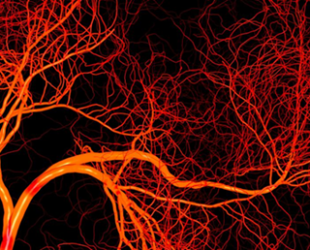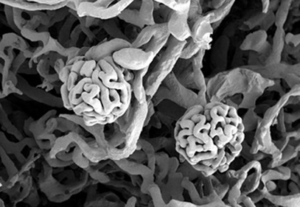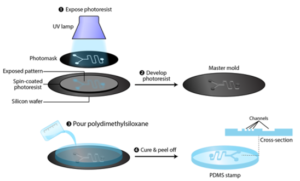Microfluidics is the science of manipulating and controlling fluids, usually in the range of microliters to picoliters, in networks of channels with dimensions from tens to hundreds of micrometers. The behavior of fluids at this scale is significantly different from “macrofluidic” behavior. For example, surface tension and capillary forces are more dominant at microscale, and flow is almost always in the laminar regime. These phenomena enable microfluidics to be used for creating exceptional flow control, formation of monodisperse droplets, and passive fluid pumping.
Laminar flow in microfluidics
Surface tension phenomena – droplet generation
in microchannel
Microfluidics is a unique technology that allows experiments to be performed in an environment that mimics the inside of the human body. For example, the smallest capillaries measure only five micrometers and can be modeled by microfluidic devices. An average sized pulmonary alveolus in an adult human being is around 100 microns and alveolar-capillary interface can be modeled by a microfluidics cell culture device replicating air-liquid interface.


Glomerular capillary bundles in the kidney
There are numerous advantages for using microfluidics in scientific research. Notably, microfluidics allow researches to improve the precision of experiments, lower limits of detection, run multiple analyses simultaneously, and reduce sample and reagent consumption.
Microfluidics is a continuously growing field with applications in cell biology research, drug discovery, point-of-care diagnostics and precision medicine, and lab-on-a –chip systems. Some examples of applications include:
Microfabrication refers to cleanroom fabrication processes used for fabricating micron scale structures on solid flat substrates. Historically, it has been developed for micro-electronic circuit fabrication, but today it is also widely used for micro-electromechanical systems (MEMS) and microfluidics devices fabrication.
Photolithography is a key technique used in microfabrication to transfer patterns onto the substrates. Fundamentally, it is an optical printing process where light is used to pattern a layer of photosensitive material called photoresist.
Soft lithography is related set of techniques to create microstructure based on molding, embossing, and printing. The terms soft comes from the fact that it utilizes soft elastomers or polymers other than silicon or glass traditionally used in semiconductor industry. The most common substrate is PDMS (polydimethylsiloxane which is rubber like polymer that is exceptionally conformable elastomer). The soft lithography has become popular in cell biology research because it is versatile, simple and relatively inexpensive while providing compatibility with biological materials (cells, gels, polymers). PDMS is biocompatible, chemically inert, transparent to light, permeable to gases, inexpensive and easy to prepare. Soft lithography is an essential method for microfluidics device fabrication.

PDMS Soft Lithography for microfluidics
It should be noted that soft lithography is not a single technique used only for microfluidic devices fabrication. Rather, it is a set of techniques that includes microcontact printing, replica molding, capillary molding, and microtransfer molding. These techniques are used for microscale structure fabrication and patterning of a wide range of materials (e.g. biocompatible polymers, hydrogels for cell culture, small biomolecules, proteins, or suspension of cells).
References:
[1] Sackmann, E.K., Fulton, A.L., Beebe, D.J. The present and future role of microfluidics in biomedical research Nature 507 (7491), 181
[2] Weibel, D.B., DiLuzio, W.R. and Whitesides, G.M. Microfabrication Meets Microbiology Nature Reviews Microbiology, 5, 209-218.